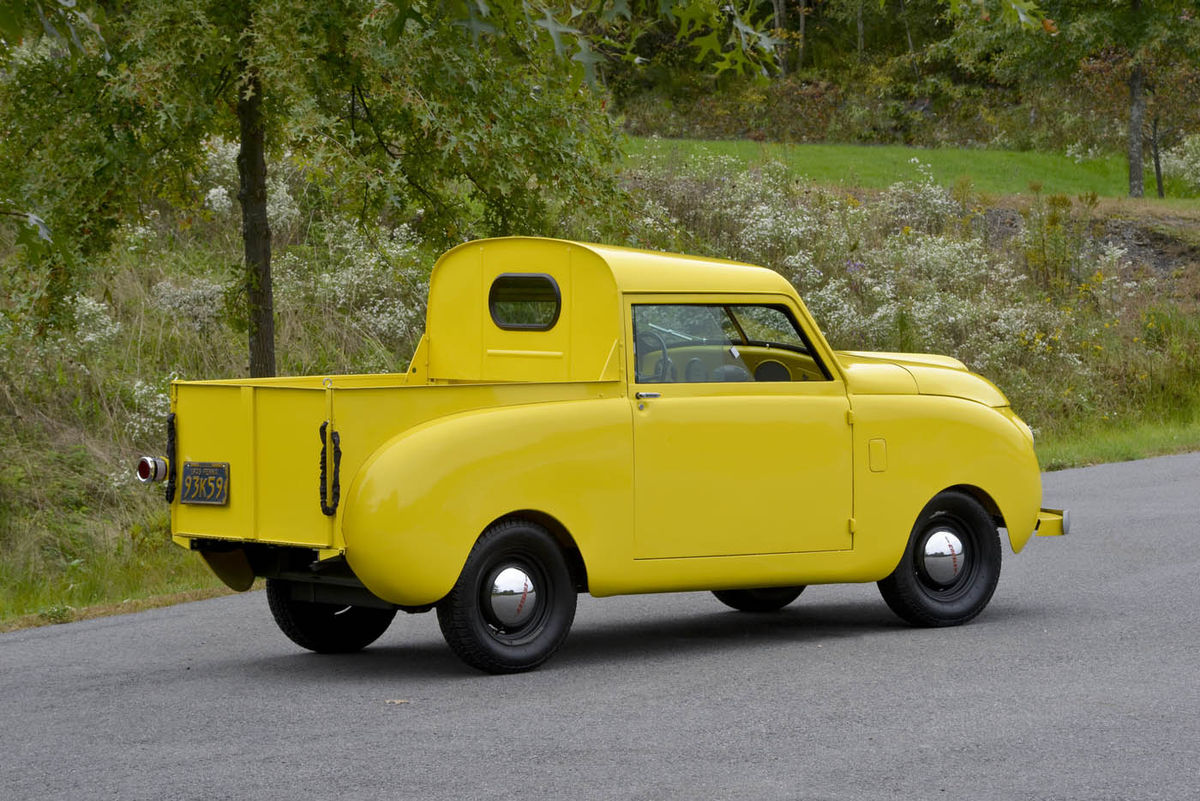1947 CROSLEY PICKUP
Was This the Start of the American Pickup Boom? Well, Maybe Not…But It Can Do a Day’s Work.
Whether Powel Crosley was right or wrong in his conviction that practicality should be paramount in designing a car, carrying that belief to the extreme told him that it was not a formula for success as an automaker.
Crosley was neither the only nor even the first figure in the automotive world to develop that philosophy. Henry Ford and Walter Chrysler—two obvious examples— followed that approach with the Model T and the 1928 Plymouth respectively and did so with absolute success, but both grasped the difference between practicality and austerity.
Crosley had tried with the affordable Marathon Six in 1909 and with the DeCross cyclecar four years later. The fact that the two are remembered only by the most knowledgeable is solid proof that they were, in effect, failures, but that didn’t stop Crosley from achieving success in everything from radio sets and radio stations to ownership of the Cincinnati Reds baseball team and the introduction of a near-legendary household appliance, the Crosley Shelvador refrigerator with its patented door-mounted shelves.
Another Try at the Auto Industry
The practical car, though, had never completely disappeared from Powel Crosley’s mind even as his business interests were making him a very wealthy man and in 1939, his new car was unveiled. This time, it wore his name. It was “the car of tomorrow at the world of tomorrow,” advertising promised, “as shown at the Crosley Building at the N.Y. World’s Fair.”
The same ad urged readers to “see the newest of the new in home appliances at popular prices…at Crosley Dealers everywhere.”
The promise of “Crosley Dealers everywhere” was no phony claim, but it didn’t state that the dealers were exclusively auto dealers. Instead, stores already selling Crosley appliances and other products could sell Crosley cars, too. It was an idea at once good and bad; good because it provided an instant dealer network and bad because the expertise at most of those operations was likely to be in equipment using vacuum tubes, heating elements or plumbing. Cars with internal combustion engines would be something new to the majority of established Crosley dealers who chose to sell them, but the situation wasn’t as difficult as it might sound.

When his dealers saw the new car for the first time, they knew that Crosley had delivered on his promise. A twocylinder air-cooled Waukesha good for 12 horsepower was adequate to move the half-ton car, sliding windows and an unsynchronized three-speed kept the price tag low and an 80-inch wheelbase meant that it might actually fit in the “showrooms” of Crosley appliance dealers.
At a time when the cheapest Ford cost $640 and Chevrolets started at $628, the sole Crosley was a convertible for $325—the equivalent of $6303 in today’s money—making it as affordable to potential buyers as it was uncomplicated to those who would have to repair it. All of that seemed to be right and from June through December, Crosley sold 2017 cars. Problems that should have been caught before the car went on sale soon turned up and 1940 sales fell to 422, but the problems were corrected and 2249 Crosleys were sold in 1941 followed by 1029 in the 1942 model year shortened by the start of World War II.
The numbers seemed respectable, but were hardly enough to suggest a ready substantial market for a tiny car or for its tiny-truck variants.
“That’s 100-percent right,” agreed Jared Cohen, whose 1947 Crosley pickup is featured here. “It just didn’t make sense, but he tried. When we went out to the (Crosley) show, there were a few people who’d bought them before and I always asked them why. No one really has a good answer for why they felt they needed a Crosley. They were cheap, but either too far ahead of their time or too far behind their time. I don’t know what it was. You certainly can’t fault the Crosley brothers for their effort, but it didn’t work.”
Developing a New Engine
Powel Crosley’s brother, Lewis, was most involved in the business side of the company, which joined the other automakers in defense production before World War II began. While Crosley contracted for radios, proximity fuses and even components for Boeing B-29 Superfortresses, what would prove most significant for the company was a watercooled overhead-cam four fabricated by copper-brazing sheet steel to form an engine. Known as the CoBra for its novel construction, it became the heart of an allnew postwar Crosley.
Few vehicles have changed so radically from one generation to the next and when the 1946 Crosleys arrived, they had little in common with the 1942 models beyond the number of wheels, the overall configuration and an undeniable charm.
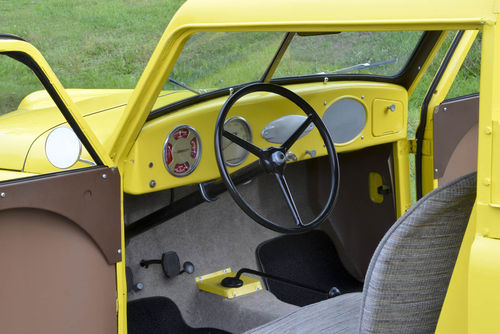

Whether passenger cars or commercial vehicles, prewar Crosleys wore the distinctly separate fenders and pointed hoods of their era. But the hoods were high and when combined with the low grilles, the pointed sheet metal where the grille should have been and the seemingly oversized freestanding headlights, the result looked like no other car on the American road. A slightly bathtubesque body for the passenger car completed the package and ensured that the Crosley had a love-it-or-hate-it look. Those who drove them—then or now—knew that the styling mattered far less than the shockingly roomy passenger compartment, the excellent fuel economy and the unmitigated fun of being behind the wheel.
Moving to a More Contemporary Design
Postwar Crosleys wore smooth sides, relatively flat hoods and curved rather than pointed noses—with headlights integrated in the sheet metal—for a far more modern look. Downward-sloping bulges on the side panels at front and rear relieved what could have been a flat, boxy design. The grilles were still low, but no longer seemed so far out of place and behind them was the 44-cubic-inch CoBra engine with its 26 horsepower. The new engine was a huge leap from the prewar Waukesha and went into the entire Crosley range, including the pickup of which only a handful were built in 1946 before its production truly got moving in 1947.
In both cars and trucks, though, the CoBra engines soon began to experience problems from electrolysis. Holes appeared from the rust, water leaked through the holes, engines heated up and the end was in sight. But while Crosley could have ignored the complaints or just given up, it instead developed a replacement engine, the CIBA with its Cast Iron Block Assembly. The specifications were virtually the same as the CoBra’s and it bolted right in, so nearly all Crosleys built with CoBras were converted regardless of whether their original engines had actually failed.
In either case, it’s difficult to argue that a 26-horsepower engine is a big one, particularly when it’s installed in a truck. As if that’s not enough, the early postwar Crosley pickup’s sloping front and rear fenders earned it the nickname “Roundside” and proved that it was really just a sedan with a small cargo box in place of the rear compartment and part of the roof. Add that up and it becomes tempting to dismiss it as a toy, but the proof of what a bad idea that is lies in the feature truck’s history.
A Mini Farm Hauler
“The pickup, I guess, was being used on someone’s farm for years and years,” Cohen explained. “He had agricultural tires on the back and he was using it around the farm. I guess the guy I bought it from got it from him in ’91 and he actively started restoring it as soon as he got it.”
In other words, it was a working truck for more than four decades, which hardly qualifies it as a toy. It did, however, qualify as even more than Cohen had dared to hope for.
“We were definitely looking for a Crosley pickup,” he said. “It didn’t have to be a Roundside; they’re hard to find. We fell on this one, but we were looking for a pickup and it didn’t matter which year.”
A Crosley pickup was important, he explained, because nearly all of the vehicles in his family’s collection are pickups and larger trucks, but there’s also a 1952 Crosley sedan. Since the sedan had led him to the Crosley Automobile Club and the Crosley Facebook group, finding the pickup was less of a challenge than it might otherwise have been. That was in September 2017 and he said that while its restoration had been started, much remained to be done. The first step was to get it from Tennessee to his home in Clark’s Summit, Pennsylvania, and driving it that distance was out of the question.
“I had had my appendix out the weekend I was supposed to go and get it,” Cohen said. “I probably would not have driven it home. It was not drivable.”
Once delivered, he found that at some point in the truck’s life, the engine had been rebuilt and there were problems.
The Engine Had Major Drawbacks…
“The engine timing was out and it was put together dirty,” he explained, “so it wiped out all the bearings that he had put in, the crank needed to be cut, stuff like that. It was not in any kind of moveable shape, so we started over. The engine wouldn’t really run. We got it to start, but the mishmash of gears running the overhead cam were all sorts of out of time, so it would idle, but it wouldn’t really run up on any kind of rpm. It wouldn’t take any throttle, so it wasn’t moveable.”
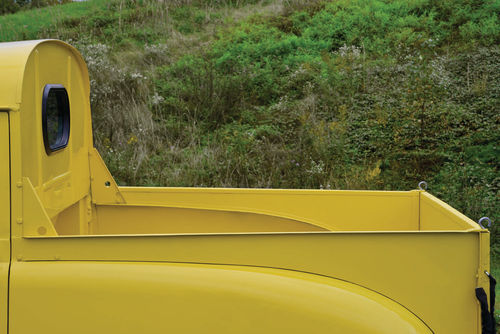
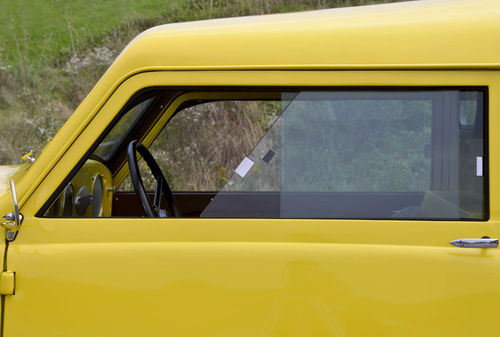
The block was in good condition, but if he’d needed a replacement, the solution was close at hand.
“Luckily, we had about 15 of them at the house,” he laughed, “because no one ever has a Crosley with only one engine. No one owns one Crosley. It doesn’t happen.”
He also provided some facts that might surprise those casually familiar with Crosleys.
“They were very reliable engines and they were rugged,” he explained. “They’re five-bolt mains and sometimes people use different crankshafts in them and they’ll run 12,000, 13,000 rpm. Stock, they’ll run just under 10,000 and they hold together. (For) three-quarter midgets, they loved these... The power-to-weight was great on them. You could get 50 or 60 horsepower out of those engines and they’re 120 pounds.”
It’s doubtful that the feature truck’s engine ever experienced anything like that during its years on the farm, especially since Cohen found nothing wrong with either the transmission or the rear end. He rebuilt the transmission just to be safe and installed new bearings in the rear, two tasks made much easier by the body’s already having been removed from the chassis.
About Those Mechanical Brakes
“I wire-wheeled the chassis and primed and painted it,” he said. “It’s a Crosley chassis, so it didn’t take that long. I would say start to finish, it was a weekend. I wanted to make sure that it looked good, but it didn’t need that much.”
The frame was broken, which sounds worse than it is as he explained that the breaks were at the rear spring mounts and not especially hard to repair. He added that it’s a somewhat common problem on Crosleys and that the springs themselves were fine.
With the body off, it also made sense to tackle the front end and he said that all of the wearable parts were in good condition, but he rebuilt the steering box, again to avoid potential problems.
The brakes, though, were something for which he and his father weren’t quite prepared despite their having experience with the sedan.
“The car has hydraulic drums,” Cohen said. “We had heard the rumors about these cable brakes and so as soon as we got it home, we pulled the wheel off and we just stared at it. The drum is only a six-inch drum and we were just staring at it and watching this series of cables run all over the place.
“We redid everything. We were able to get new cables, put everything back together, got ‘all’ of the adjusters freed up. They didn’t even go for two on this one. There is one adjuster for both shoes, which is kind of interesting, too, and no adjuster on the top. We replaced the cables and went through the brakes and the little center floating shaft that keeps tension on all four cables. We marveled over that for a while, too, at how simply creative it was. It’s as basic as it gets, but it works well.”
Some “Working Truck” Repairs
There are those who recoil in horror at the mention of mechanical brakes, but Cohen’s driven the Crosley more than 600 miles and he’s found no reason to worry. Before he was able to take it out on the road, of course, there was the matter of dealing with the body and interior, where he was fortunate that only “trinkety stuff” was missing and the sheet metal for the most part was in good condition.
“There was no rust on the outside of the pickup,” Cohen said, “except near the bottom of one of the doors, we had to do a little tiny patch. It was right on the outside, right on flat sheet metal. I don’t know why it rotted out there. The bottom was fine.
“We put in a full floor from the firewall all the way to the bed. The bed floor was fine. (The cab floor) is at the same height as the bed floor. It’s all the same piece, but that’s where we stopped.”
The kind of damage typical on a working truck was also there.
“The tailgate was rough,” Cohen said. “(The uprights) were fine, the tailgate was rough. The tailgate has odd seams all over it, I don’t know why, and it’s actually very heavy, which you wouldn’t expect. The tailgate took a little bit of effort because the seams had started to open up, so we had to redo quite a bit of it.”
Since finding a good replacement would have been difficult, fabricating was the only other option had the original been unsalvageable. Cohen noted that its problem was dents rather than rust, as the gate’s design keeps it from trapping the debris and moisture that eventually lead to rotting.
He also said that when the body was stripped, earlier repairs could be roughly dated by the materials used, with lead likely the earliest and plastic filler probably dating to the Crosley’s later years on the farm. That left bodywork still to be done which—for one very obvious reason— might have been the most daunting phase of the restoration.

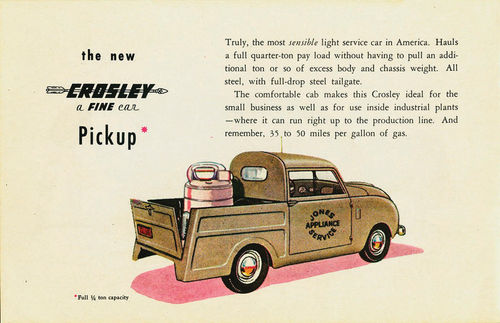
“There are a billion hours of bodywork because the sides are rounded,” Cohen said. “My father is very strict about his bodywork and paint. In his opinion, that’s the most important part of the restoration and he is ungodly tedious with his bodywork. I would not be even remotely surprised if there were 200 hours of bodywork on that.”
If he feels that way, he must enjoy bodywork, right?
“No,” Cohen said, “hates it. He absolutely hates it. Every time we get (a vehicle) done, he says ‘I’m never doing bodywork again. I’m not painting again’ and then the next time it comes around, we ask a hundred people to do it and no one really likes to do that kind of bodywork anymore and it ends up where he just says ‘forget it, I’ll do it myself.’ The same thing happened with this and we painted this one ourselves, too, which we don’t usually do. We usually just do the bottom and the firewall so that we can put it together.”
Who Put That Hole In the Door Trim?
When it came to the interior, they were spared at least some work as the seats were already upholstered, but they chose to make improvements by installing carpet in place of the correct rubber mat and adding Dynamat throughout the cab. The plan was to reduce the noise, but Cohen said that it made less difference than expected.
“It’s still very loud,” he said.
On the dashboard, the speedometer is original to the truck and the rest of the gauges were pieced together from various others. Interior trim on the driver’s door is from a newer parts car and was slightly redesigned to eliminate an inconvenient quirk. The piece is sheet metal, rides below the window and fits perfectly, but it doesn’t quite match its opposite on the passenger’s side.
“On the 1949 model-year Crosleys,” Cohen said, “they changed the body style, but they did not yet change the window style and so it still had sliding windows instead of the later roll-down windows. They used the same door panels and the same metal trim, but on the later ’49s, they moved the (interior) door handle to the front of the door.
“We had a parts car that was a ’49 that we stole this from, but it has the extra hole in the front for the handle and we figured that out after we put it in. We covered it up from the back, so you’ve got to be looking for it to tell. We normally would’ve fixed it, but it was in and painted before we realized that there was an extra hole. I was sitting in the cab, I think we were putting in the windshield and I happened to look over to my left and I could see right through it and I looked to the right and it wasn’t there. I went back out to the car and the door handle was on the front on the later ’49 cars and it’s not on the earlier ’49 and back.”
Parts Are Available
Door handles aside, anyone who’s looked over a Crosley would agree that it’s one of the least complicated vehicles out there, something that recommends it as a good candidate for the first-time restorer.
“It’s perfect for it,” Cohen agreed. “It’s small, it’s easy to handle, parts are available; books are available.”
To some degree, that goes back to Powel Crosley’s philosophy, but there’s also the matter of the support that’s available today. About 90,000 Crosleys were produced, so while the popularity and knowledge base don’t match those of perennial favorites such as Model Ts and 1957 Chevrolets, it speaks incredibly well for the cars (and trucks) that both parts and help are in good supply.
“Very,” Cohen agreed. “Parts are no problem. Everything you need, used, new, whatever, someone’ll find it for you. Everything’s available, which is astonishing.” Among the facts that support his position is that the truck’s body-off restoration required less than one year for completion. Admittedly, he and his father are experienced, but neither their background nor their goal-focused timetable diminishes the accomplishment.
“We got done at 4:40 in the morning, July 11,” Cohen said. “Well, so I’m told and I’ll explain why. We had planned on going to the Crosley (Automobile Club) National since we had bought the pickup and really, since we’ve had the car. We figured that we had to go just to experience it. So it was getting closer and closer to July and we were working faster and faster. We’d gotten to the point where it was the week before and the truck was painted but that was about as far as it had gotten and we had a week to go to finish the truck and make it drivable so that we could drive it from the hotel to the show. Around 1 o’clock (in the morning), I went to sleep so that I could drive to Ohio and my father wrapped it up at 4:40. Then we put it on the trailer and off we went.
“Of course, it’s never truly done, but that’s when it was drivable.”
Their mad dash across Pennsylvania and then most of Ohio to Wauseon took a little longer than expected and they missed the tour that was part of the meet, so the pickup only covered about 10 miles on its own that weekend. Once they were home, the final details were addressed and two weeks later, it made several local trips that added up to about 60 miles, all with no problems.
Life Imitates Advertising
More recently, Cohen came close to recreating a 1948 ad showing a pickup— lettered for “Jones Appliance Service”— toting a washing machine.
“We had a treadmill that my sister wanted,” he explained, “so the treadmill went in the back of the Crosley and we took it to her home. It was a normal-size treadmill, but it did fit and we took it, no problems.” Powel Crosley might’ve been off the mark 80 years ago with his unwavering passion for practicality, but wherever he is today; he’s having the last laugh.

